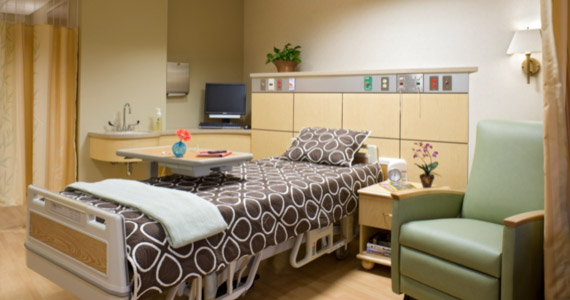

The broad spectrum of hospital room types required for most Acute Care Hospitals can appear daunting. From rooms used specifically for surgical needs, pediatric, oncology, critical care, obstetrical and more, the needs for specialized rooms in the past has been crucial in hospital design. Typically these room types are determined by facility service lines, demographics and market share or competition. However, evidence-based design and space limitations are moving interior healthcare design toward a Universal Room concept that allows for facilitation of multiple forms of patient care. In general, the concept of a Universal Room for Acute Care refers to the requirements from a Medical/Surgical room type to a Critical Care (either ICU or CCU) room type.
Medical/Surgical
Per the AIA Guidelines, the minimum requirements for a Medical/Surgical patient room is 120 SF of clear floor space and a minimum clear dimension around the sides and foot of the bed of three feet. However, in the recommendations, the Guidelines recommend a minimum dimension of 12 feet wide by 13 feet deep yielding approximately 160 SF. In practice, with the move for greater family participation in the healing process, rooms range from 240 SF – 280 SF, not including the patient bathroom. In addition, Guidelines require at least 10% of the rooms on a specific Unit to be ADA compliant. This yields a bathroom that is a minimum of 65 SF. So, in general, today’s typical patient room ranges from 300 SF – 340 SF.
ICU/CCU
By comparison, the AIA Guidelines minimum requirements for a ICU/CCU patient room is 200 SF of clear floor space and a minimum headwall dimension of 13 feet, minimum dimension of one foot from headwall to bed, five feet from foot of bed to footwall, five feet on transfer side of bed, four feet on non-transfer side. In practice, these rooms range from 360 SF – 400 SF depending on types, sizes and quantity of equipment being utilized in the rooms. In addition, there has been a move to utilize traditional bathroom configurations in lieu of the Patient Care Module for patient privacy when they are able to move to-and-from the bathroom.
Acuity Adaptable Room
The concept of a Universal Room is to design all patient rooms to accommodate the most stringent requirements that may be utilized in that room. So, in terms of an Acute Care Hospital we would design each patient room to accommodate ICU/CCU requirements as well as 100% ADA compliant bathrooms incorporating the latest Best-Practices for Hospitality feel and Family-Focused Patient Care. However, the facility must be aware of the potential impact overall to these incremental changes multiplied over the entire bed configuration.
Impact of Room size to Unit size
• 24-Bed Unit
• 36-Bed Unit
Taking a modest, conceptual analysis of simply the patient room impacts, the change in a “typical” 24-bed unit at today’s general room range creates a unit that is 7,200 SF – 8,200 SF of purely patient rooms. For a Universal Room concept, this increases to a range of 8,600 SF – 9,600 SF of purely patient rooms. Taken on a more conventional 36-bed unit creates a “typical” range of 10,800 SF – 12,200 SF or a Universal Room range of 13,000 SF – 14,400 SF. At the broadest sense of the comparison this could represent a cost increase of $800,000 – $2,000,000 depending on local construction cost ranges per 36 bed unit. The benefit of utilizing a Universal Room configuration is complete flexibility in utilizing any room for any patient needs and matched to maximum staffing efficiency. So, although the upfront incremental costs could be shocking, the flexibility, utilization and life-cycle benefits long-term can represent an increased market share opportunity and ROI for the facility.




